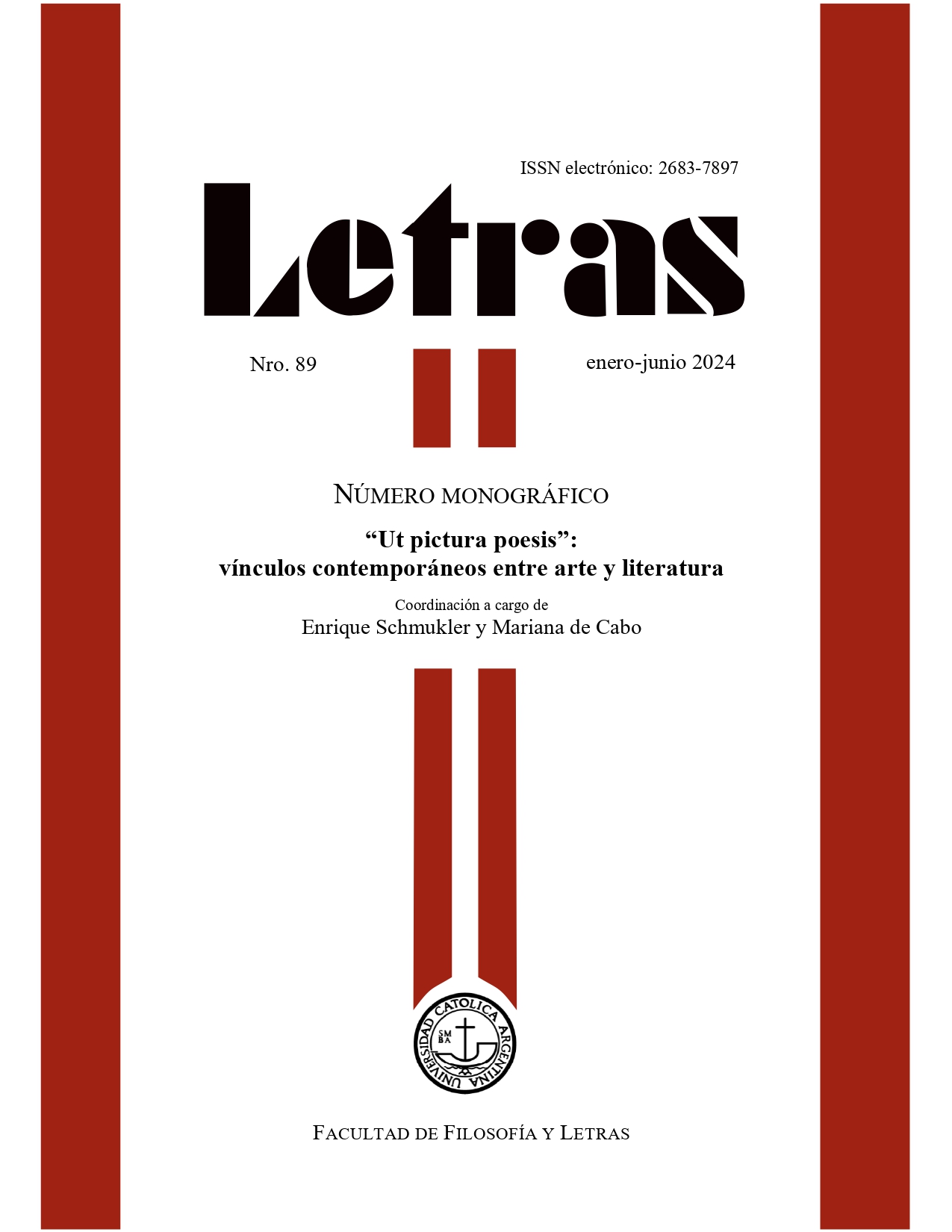Girondo: the Materialisation of Rhythm
DOI:
https://doi.org/10.46553/LET.89.2024.p153-166Keywords:
Avant-garde, Rhythm, Visual poetryAbstract
It is a commonplace of criticism to point out that Oliverio Girondo is a visual poet. This is undoubtedly an irrefutable conclusion, which can be seen in the poet's paintings and in the very composition of the book-object Veinte poemas para ser leídos en el tranvía (Twenty Poems to be Read on the Tram). However, in this article we explore a supplementary aspect, which becomes evident in the analysis of the famous calligram “Espantapájaros” (“Scarecrow”). It is a spatialisation of rhythm. Girondo’s calligram simulates a unified body in iconic figuration, but dismembered when expressed as a poem. As Henri Meschonnic points out, calligrams are “dynamic vectorisations that graphically actualise the saying”. The meaning of “Scarecrow” in typography consists of a spatialisation that is evident to the naked eye, but it also has a material, ideogrammatic rhythmicity, situated between oral rhythm and typographic rhythm. The reading of the poems of En la masmédula and the subsequent oralisation in Girondo’s own recordings in the 1960s reinforce this rhythmic dimension of his poetics. The oralisation of En la masmédula is not a mere sound version, but a culminating act: the final materialisation of the oral rhythm in the voice, derived from a spatialisation of rhythm. here is no meaning in this materialistic diction of rhythm but significance: meaning in its sensory unfolding and space in its prosodic depth. The poem as a unity of meaning, and not the verse. That would be the aim of Girondo’s poetic project: to concretise the materialisation of rhythm in the double spatial and temporal dimension.
Downloads
References
BENJAMIN, Walter, 2014, Calle de mano única, Edición de Jorge Monteleone, Buenos Aires, El cuenco de plata.
BORGES, Jorge Luis, 1923, Fervor de Buenos Aires, Buenos Aires, [Edición del autor] Imprenta Serantes.
CAMPOS, Augusto de, 2012, “Poesía concreta”, en Poemas, Edición crítica de Gonzalo Aguilar, Buenos Aires, Gog y Magog, pp. 110-111.
CORRAL, Rose, 1992, “Aproximación a un texto de vanguardia: Espantapájaros, de Oliverio Girondo”, en Actas del X Congreso de la Asociación Internacional de Hispanistas (21-26 de agosto de 1989), Barcelona, Promociones y Publicaciones Universitarias, pp. 555-562.
CUADRADO, Arturo, 1984, “Testimonio de Arturo Cuadrado”, XUL. Signo viejo y nuevo, n° 6 (mayo 1984), pp. 10-11.
FERNÁNDEZ MORENO, Baldomero, 2019, Ciudad, Edición de Jorge Monteleone (Serie de los dos siglos, 31), Buenos Aires, Eudeba.
GIRONDO, Oliverio, 1999, Obra completa, Edición crítica de Raúl Antelo (coord.), Colección Archivos 38, Madrid, ALLCA XX, Universidad de Costa Rica / Université Paris X.
GIRONDO, Oliverio, 2014, Membretes. Aforismos y otros textos, Edición de Martín Greco, Buenos Aires, Losada.
GRECO, Martín, 2004, “El ‘intrafondo eufónico’. Estudio de la métrica de Oliverio Girondo”, en Carlos García y Dieter Reichardt (comps.), Las vanguardias literarias en Argentina, Uruguay y Paraguay. Bibliografía y antología crítica, Frankfurt/Madrid, Vervuert/Iberoamericana, pp. 387-414.
GRECO, Martín, 2021, La poesía siempre es lo otro. La trayectoria intelectual de Oliverio Girondo, Tesis doctoral inédita. Disponible en: http://repositorio.filo.uba.ar/handle/filodigital/16260?show=full.
KAFKA, Franz, 2018, Cartas (1900-1914). Obras completas, IV, Edición dirigida por Jordi Llovet, Barcelona, Galaxia Gutenberg.
MALLARME, Stéphane, 1995, Correspondance. Lettres sur la poésie, Édition de Bertrand Marchal, Paris, Gallimard.
MALLARME, Stéphane, 1965, “Préface à un Coup de Dés”, en Oeuvres complètes, Édition de Henri Mondor et G. Jean Aubry, Paris, Bibliothèque de la Pléiade, pp. 455-456.
MESCHONNIC, Henri, 1982, Critique du rythme. Antropologie historique du langage, Paris, Verdier.
OROZCO, Olga, 1978, “Oliverio Girondo frente a la nada y lo absoluto”, Cuadernos Hispanoamericanos, n° 335 (mayo 1978), pp. 226-250.
PORRÚA, Ana María, 2011, “La puesta en voz de la poesía”, en Caligrafía tonal. Ensayos sobre poesía, Buenos Aires, Entropía, pp. 147-206.
PRIETO, Martín, 2006, “Libertad y método en los poemas de Oliverio Girondo”, en Breve historia de la literatura argentina, Buenos Aires, Taurus, pp. 232-236.
SCHWARTZ, Jorge (comp.), 2007, Oliverio. Nuevo homenaje a Girondo, Rosario, Beatriz Viterbo Editora.
VALERY, Paul, 1959, “Le Coup de Dés, lettre au directeur des Marges”, en Oeuvres, I, Edition de Jean Hythier, Paris, Gallimard, pp. 491-498.
VILARIÑO, Idea, 2016, La masa sonora del poema, Edición de Ignacio Bajter, Montevideo, Biblioteca Nacional de Uruguay.
Downloads
Published
How to Cite
Issue
Section
License
Copyright (c) 2024 Jorge Monteleone

This work is licensed under a Creative Commons Attribution-NonCommercial-ShareAlike 4.0 International License.












